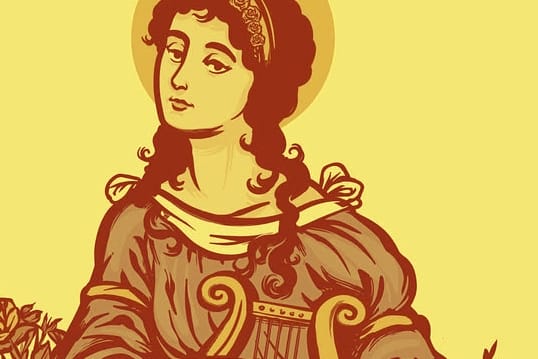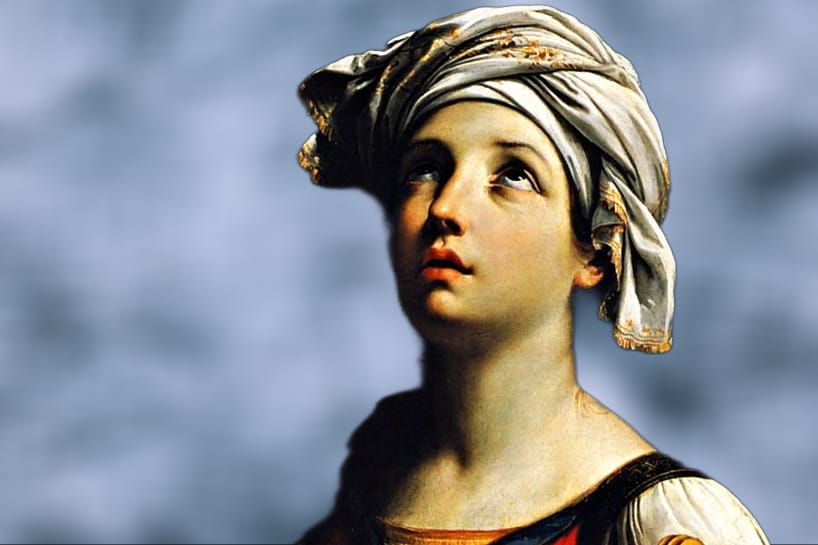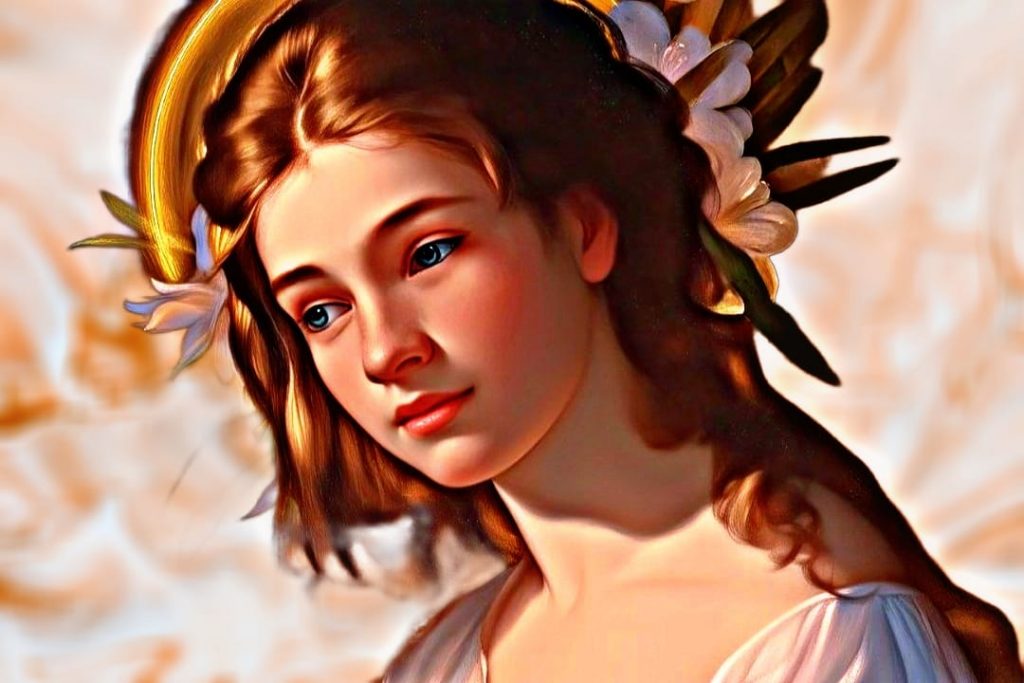Saint Cecilia, one of the most celebrated figures in early Christian history, is known as the patron saint of musicians. Revered for her unwavering faith, her connection to music, and her remarkable martyrdom, her story continues to inspire millions across the world. Cecilia’s life, though shrouded in mystery and legend, has left a lasting impact on the Christian faith and music culture. Her feast day, celebrated on November 22nd, is an occasion for honoring her devotion to God, her contribution to the arts, and her sacrifice.
This article delves into the fascinating life of Saint Cecilia, exploring her history, the miracles attributed to her, her legacy, and her role in Christianity as a symbol of devotion, music, and martyrdom. It also touches on her influence on art, music, and the broader Catholic tradition.
The Life of Saint Cecilia

Saint Cecilia was a noblewoman in Rome, living during the late 2nd century or early 3rd century. Though the exact details of her life are uncertain, her story is surrounded by a rich tapestry of legend and religious symbolism. The earliest sources about her life come from the Acts of Saint Cecilia, a hagiography written in the 5th century. This text, though not historically verifiable in all aspects, provides key insights into her character and martyrdom.
A Christian Woman in a Pagan World
Saint Cecilia is said to have been born into a wealthy Roman family. From a young age, she dedicated herself to a life of chastity and devotion to Christ. According to the Acts of Saint Cecilia, her parents had arranged for her to marry a man named Valerian, a pagan. However, Cecilia had already promised her virginity to God and was deeply committed to her faith.
On her wedding night, Cecilia, who had been praying and singing hymns to God in her heart, was miraculously preserved from consummating her marriage. According to the legend, as she explained to Valerian her vow of chastity, an angel appeared to protect her, marking her as a divinely chosen virgin. Eventually, Valerian converted to Christianity after being moved by Cecilia’s steadfast faith, and he, too, was baptized.
Cecilia’s life of prayer and devotion, coupled with her role in the conversion of her husband and others, became central to her legacy. While her marriage to Valerian is often considered an act of holy obedience, it also illustrates her strength and resolve in living out her Christian beliefs, even in the face of societal expectations.
Saint Cecilia Role in Spreading Christianity
Saint Cecilia actions during her lifetime were deeply connected to her commitment to spreading Christianity in a time of Roman persecution. She is believed to have been a part of a larger Christian community in Rome that worked clandestinely, sharing their faith in secret due to the oppressive nature of Roman imperial rule. Cecilia is said to have used her wealth and influence to support the Christian church, helping to bury martyrs and assist in the care of those persecuted for their faith.
Her courage and resolve during these turbulent times made her a powerful figure within early Christian circles. The Acts describe how Cecilia, along with her husband and brother-in-law, was arrested for defying Roman authorities and practicing Christianity. Despite being ordered to renounce her faith, Cecilia remained steadfast, even in the face of death.
Martyrdom and Legacy
Saint Cecilia martyrdom is one of the most powerful aspects of her legacy. After her arrest, she was sentenced to death by beheading. According to the legend, she was first condemned to be suffocated in a bath, but when she survived this attempt on her life, she was beheaded. Miraculously, after being struck three times with a sword, she lived for three days, during which she continued to pray and convert people to Christianity. It is said that during this time, she was visited by the pope, Urban I, who anointed her as a saint.
Her death marks her as a symbol of unshakable faith and unwavering commitment to God, despite the ultimate cost. Cecilia’s story of martyrdom became a powerful tool in the early church’s evangelizing efforts and served as an inspiration for later generations of Christians.
The devotion to Saint Cecilia grew rapidly in the centuries following her death. The 5th-century Acts of Saint Cecilia recounting her life, along with early depictions of her in Christian art, contributed to her veneration as one of the early martyrs of the Christian faith.
Saint Cecilia and Music: The Patroness of Musicians

One of the most enduring aspects of Saint Cecilia’s legacy is her association with music. The title of “Patroness of Music” has been ascribed to her for centuries, although the origins of this association remain a subject of debate.
The Legend of Cecilia and Music
The connection between Cecilia and music stems largely from the Acts of Saint Cecilia, in which she is described as singing hymns to God in her heart, even on her wedding night. The phrase “singing to God in her heart” is often interpreted as a metaphor for her deep spiritual devotion, but it has also been viewed as symbolic of music’s role in her life. Some scholars believe that Cecilia’s status as a musician may have been a later addition to her legend, reflecting the growing association between saints and the arts, particularly music.
According to one version of her story, as she was being married, Cecilia instructed her husband, Valerian, that she could not be with him because her heart belonged to God, and she was filled with divine music. Her love for God and her singing were symbolic of the joy and beauty that music brought to her soul.
In time, Cecilia became synonymous with music because of this spiritual connection to song and praise. Early Christian composers, musicians, and church leaders began to honor her in their musical works, and thus she became the patroness of all musicians.
Music, Art, and the Depiction of Saint Cecilia
Throughout the centuries, Saint Cecilia has been a popular subject in Christian art, often depicted with musical instruments such as the organ, harp, or lute. These visual representations serve as a constant reminder of her deep connection to music and her elevated status as the protector of musicians.
Some of the most famous artworks featuring Saint Cecilia include paintings by artists like Raphael, Guido Reni, and Domenichino. These works often show her playing a musical instrument or surrounded by angels singing or playing music, further cementing her association with the art of music.
Saint Cecilia has also been the inspiration for many musical compositions, especially during the Baroque period. Composers like Handel and Henry Purcell created oratorios and musical pieces dedicated to her memory and celebrating her role in the Christian tradition. The famed St. Cecilia Mass by Franz Joseph Haydn and Benjamin Britten’s Hymn to Saint Cecilia are prime examples of musical tributes to the saint.
The Feast Day of Saint Cecilia

Saint Cecilia’s feast day, November 22nd, is widely celebrated by Christians, especially by those in the music community. On this day, the Catholic Church honors her life, martyrdom, and musical legacy. The feast day is marked by special prayers, church services, and musical performances in her honor. Many choirs and orchestras also take this day as an opportunity to perform sacred music, reflecting the saint’s patronage of music.
The day has also become a significant occasion for musicians to gather in reflection, not only to honor Saint Cecilia but also to celebrate the role of music in Christian worship. For many, it is a time to reflect on the spiritual power of music as a tool for connecting with God.
The Influence of Saint Cecilia in Modern Times
Today, Saint Cecilia remains a deeply influential figure, particularly in the realms of music and the arts. As the patroness of musicians, she continues to inspire composers, singers, and performers around the world. Many music schools, conservatories, and professional music organizations have adopted her name, and her image appears in concert halls, music festivals, and institutions that seek to elevate the connection between music and spirituality.
Additionally, Saint Cecilia’s unwavering commitment to her faith in the face of persecution resonates with modern Christians facing challenges in maintaining their beliefs in a secular world. Her story is one of courage, perseverance, and the transformative power of music as an expression of devotion.
Conclusion: Saint Cecilia’s Enduring Legacy
Saint Cecilia’s life and legacy have stood the test of time. As one of the most revered saints in Christian history, she represents the intersection of faith, art, and martyrdom. Her role as the patroness of music underscores the importance of artistic expression in Christian worship and human devotion. Through her story, Saint Cecilia reminds us of the power of music to uplift the soul and connect the faithful with the divine.
Her feast day on November 22nd continues to serve as a reminder of the rich spiritual legacy she left behind and her deep connection to the arts. Whether through her influence in sacred music or her example of unwavering devotion, Saint Cecilia’s legacy remains an enduring source of inspiration for Christians and musicians alike

